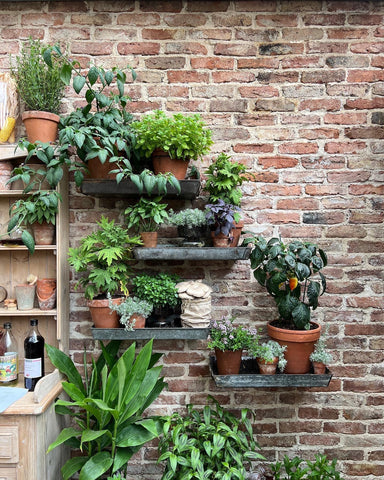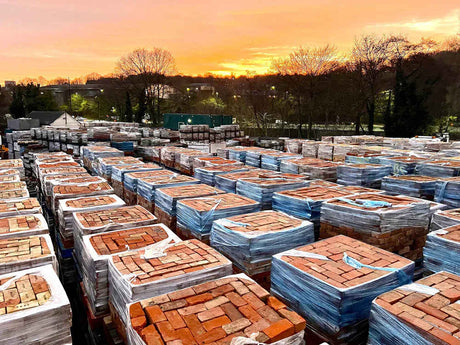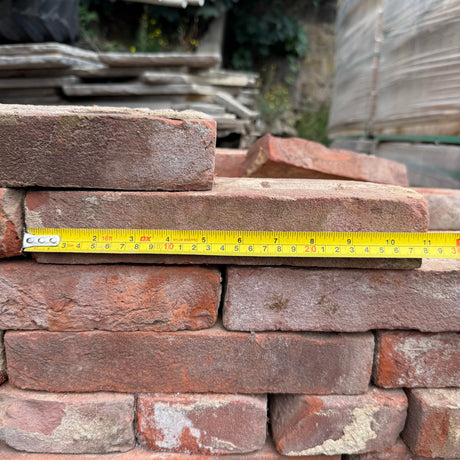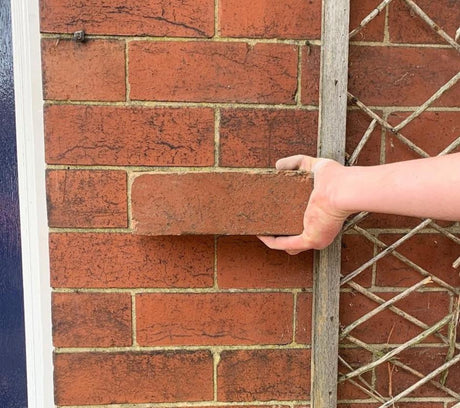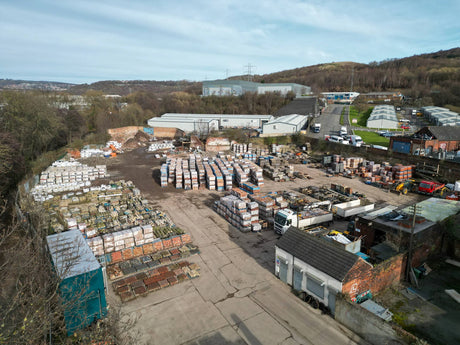Value on Vintage: How Reclaimed Items Can Boost Your Home's Worth
Written by Reclaimed Brick Company, UK
There's a charm to old things, an aura of history that new items can't match. In today's world, where mass production is the norm, items from the past have a special appeal. And this appeal can translate to an increase in your home's value. If you're curious about how incorporating reclaimed items can elevate your space and its worth, read on.

A Brief Overview of Reclamation Yards
Before we delve into the core of our topic, let's quickly understand what a reclamation yard is. In the simplest terms, reclamation yards are places where salvaged items - those saved from demolition sites, old houses, factories, and more - find a second life. From vintage tiles, old wooden beams, to antique furniture, these yards are treasure troves of history and craftsmanship. If you go and take a look around you will be surprised at what individual and quirky items you can find.
The Rise of Vintage Appeal
The vintage wave isn't new. People have been drawn to older items for decades. But the rise of platforms like Pinterest, Instagram, and various home décor shows has amplified this trend. The global shift towards sustainability has also made reclaimed items more appealing, as they reduce the need for new resources and keep usable items out of landfills.
There are now so many videos online about restoring vintage or reclaimed furniture and how to use them in your home to add a unique feel.

Reclaimed Wood Boosts Authenticity
One of the most sought-after items in reclamation yards is wood. Reclaimed timber beams, flooring, or furniture can transform a space instantly. This wood, often with visible age, knots, and unique imperfections, adds an authenticity that's hard to replicate with new materials. Even better if it has a story behind it. We often get pieces from old, demolished pubs or buildings that have an amazing history from the local area and personal connections from local residents.
-
Benefits:
-
Eco-friendly: Using reclaimed wood reduces the demand for new timber.
-
Unique Aesthetics: Every piece has its history and story.
-
Durability: Older wood, especially from historic structures, tends to be from mature trees, making it stronger and more resilient.
-
Vintage Tiles and Aesthetics
Reclaimed tiles, especially those with intricate designs, can be focal points in a room. Whether used for a kitchen backsplash, a bathroom floor, or a fireplace surround, these tiles add a touch of vintage class.
-
Benefits:
-
Distinct Designs: Patterns that might not be in production anymore.
-
Time-tested Durability: They've already stood the test of time.
-
Easy Maintenance: Many older tiles were made to last, requiring minimal upkeep.
-

Antique Fixtures: Elevating Spaces
Light fixtures, door knobs, taps – the details in a home can make all the difference. By incorporating vintage fixtures, you infuse character into your space. Think of a Victorian-era chandelier in a dining room or an Art Deco doorknob. These small touches can be conversation starters.
The Charm of Vintage Furniture
While modern, minimalist designs have their audience, there's no denying the appeal of a well-made antique dresser or a rustic wooden dining table. These items not only serve their functional purpose but act as statement pieces, setting the tone for the room.
-
Benefits:
-
Craftsmanship: Older furniture often boasts superior craftsmanship.
-
Uniqueness: Less chance someone else will have the same piece.
-
Investment Potential: Some vintage pieces can appreciate in value over time.
-
Environmental and Economic Impacts
Besides aesthetic appeal and uniqueness, using reclaimed items is a nod to sustainability. You're reducing waste, conserving resources, and supporting local businesses and reclamation yards. Often, buying reclaimed is also cost-effective in the long run due to the durability of vintage items.
Adding Value to Your Home
While the joy of living in a space that reflects your personality and preferences is invaluable, there's also a monetary side to it. Homes with unique character often fetch a higher price in the market. Potential buyers appreciate the authenticity and charm that reclaimed items offer, making your home stand out in a sea of cookie-cutter designs.
Tips for Incorporating Vintage
-
Do Your Research: Know the origin and history of items.
-
Mix and Match: Blend modern and vintage for a balanced look.
-
Consult Experts: Especially for structural items like beams or flooring.
-
Maintain Well: Ensure longevity by taking care of your vintage finds.
Reclaimed items are more than just 'old things'. They're fragments of history, pieces of art, and embodiments of craftsmanship. By integrating these treasures into your home, you're not only boosting its aesthetic appeal but also its market worth. So, the next time you're considering a home revamp, remember that sometimes, the old can be gold.
The Story Behind the Items
One of the most compelling aspects of using reclaimed items is the stories they carry. Imagine a centennial wooden beam that once supported a historic cottage or tiles from a 19th-century manor. Every nick, scratch, and mark has a story to tell, adding layers of depth and narrative to your space.
-
Engage in Conversations: When guests ask about the origin of a particular item, you've got an engaging tale to share.
-
Historical Significance: Some reclaimed items might have historical or cultural relevance, adding weight to their value.
The Historic Craftsmanship
Modern mass production often prioritises speed over skill. Vintage items, on the other hand, were crafted in an era where time, effort, and artisanal skill were paramount. The attention to detail, the handiwork, the unique designs - all these elements can rarely be replicated in today's fast-paced production lines.
-
Handcrafted Detailing: Many reclaimed items feature handcrafted details, making each piece truly one-of-a-kind.
-
Quality Materials: Older items were often made from materials sourced for their durability and quality rather than cost-efficiency.
Sustainability and Ethical Choices
Incorporating reclaimed items goes beyond aesthetic appeal. It’s a conscious choice to reduce consumption, waste, and the carbon footprint. Given the mounting concerns about global warming and environmental degradation, every sustainable choice makes a difference.
-
Upcycling: Giving new life to old items is a form of upcycling, a green initiative that minimises waste.
-
Conscious Consumption: Instead of buying new, opting for reclaimed items is a decision to consume responsibly.
Customisation Opportunities
One of the joys of reclaimed items is the opportunity they offer for customisation. An old wooden door can be repurposed as a unique dining table. Vintage crates can be transformed into quirky shelves. With a bit of creativity, the possibilities are endless.
-
Personal Touch: Tailoring reclaimed items to fit your space allows for a personal touch that's hard to achieve with off-the-shelf products.
-
DIY Projects: For those who love DIY, reclaimed items offer so many project ideas. Plus, there’s immense satisfaction in breathing new life into old treasures.
Cost Implications: A Wise Investment
While some reclaimed items might come with a higher upfront cost, the investment often pays off in the long run. Vintage items, given their build quality and materials, tend to last longer. Moreover, as they become rarer, their value might appreciate, making them assets rather than mere decorative pieces.
-
Long-term Savings: Instead of replacing cheaply made new items every few years, a one-time investment in quality reclaimed items can offer longer durability.
-
Asset Appreciation: Items, especially those with historical or artisanal significance, can appreciate in value, offering a good return on investment.
Supporting Local and Small Businesses
Opting for reclaimed items often means supporting local reclamation yards, artisans, and small businesses. Instead of fueling the machine of mass production, your money goes to local communities, craftsmen, and entrepreneurs.
-
Economic Boost: Local businesses often reinvest in the community, creating a positive economic cycle.
-
Preservation of Skills: Supporting artisans ensures that traditional craftsmanship skills, which are fast dwindling, get passed on to future generations.
The Role of Reclamation Yards
Reclamation yards play a crucial role in this vintage revival. By rescuing and preserving items that would otherwise be discarded, they offer a bridge between the past and present. Their expertise can guide homeowners, designers, and enthusiasts in selecting, restoring, and installing reclaimed items.
-
Expert Guidance: Reclamation yards often house experts who can provide insights into the history, care, and potential uses of items.
-
Restoration Services: Many yards offer restoration services, ensuring that vintage items are brought back to their former glory while retaining their historic charm.
The Timeless Allure of Vintage
Incorporating reclaimed items into your home isn't just a design choice; it's a statement. It's a nod to history, craftsmanship, and sustainability. It's about cherishing the old while crafting the new. As we move forward in an increasingly digital age, there's comfort in the tangible, tactile, and real. And perhaps that's the most significant value vintage brings a connection to a world that once was, anchoring us as we navigate the future.


